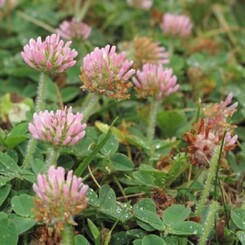Strawberry Clover
Trifolium fragiferum
A persistent prostrate perennial legume that regenerates readily by shedding seeds and spreading stolons. Its stems are slender and branched the roots can grow to 250 mm. Trifoliate leaf size varies between cultivars, flower heads are small, and pink, resembling strawberry fruits. Seed pods contain 1-2 seeds.
Uses are as ground cover in vineyards, orchards and for green cover crops and soil conditioning.
pros
Very palatable and nutritious - making an excellent component in a permanent pasture in spring and summer
High protein content
High digestibility
Tolerates heavy grazing
Tolerates wide temperature range with good heat tolerance
Excellent summer feed value when moisture is available
Drought and water-logging tolerant
Tolerant of salinity - can establish and persist on wet saline and alkaline soils where other clovers struggle to persist
Grows best, pH 6-8. can tolerate pH 4.8
Prefer rainfall greater than 500 mm
Olsen soil P > 15
Very persistent on suitable soils
Importantly free of oestrogen risk
cons
Slow to establish - poor seedling vigour makes establishment hard in already established pastures.
Poor winter growth
A high proportion of hard seed
Requires soil moisture through summer
Seed easily spread by water, birds and livestock
Intolerant of deficiencies in K, Mo, Cu, S
Suggested Mixtures
Grasses: phalaris, tall fescue, perennial ryegrass, tall wheatgrass,
Legumes: Persian, Balansa, White clovers
Sowing/planting rates as single species
1-2 kg/ha; sow scarified seed at 15-20 mm into a clean, finely worked seedbed and roll
Sowing/planting rates in mixtures
0.25-0.5 kg/ha
Sow Early autumn or spring; low seedling vigour


